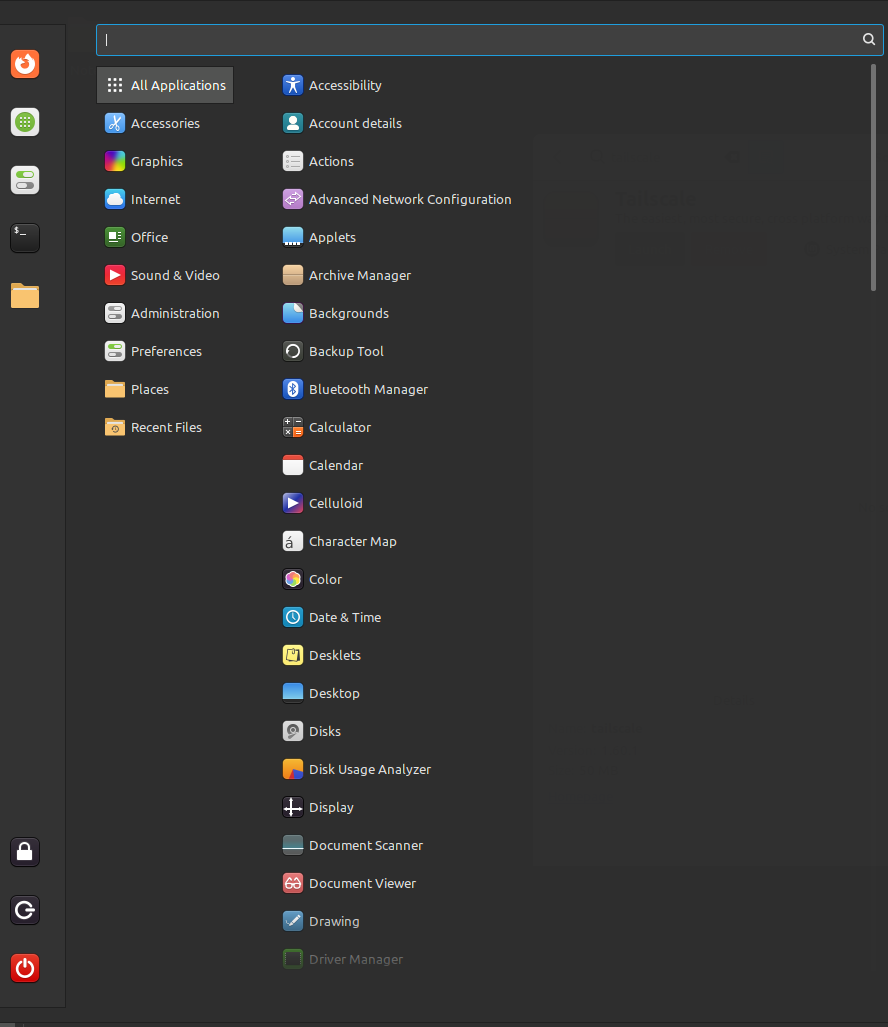I left 10 years ago and decided to come back to see if things have improved.
It’s 90% there, but there are still too many bugs and quirks that think I I’m going to go back to Windows.
I started my reintroduction to Linux using Mint. Mint is pretty good, but the UX design was terrible and the “start menu” would lose its relative aspect ratio and my 4k monitor would display a 400x200 pixel start menu. Also, when trying to install apps using flatpak, the results was convoluted. I am trying to install tailscale. Why are there so many results? Which one do I need? Maybe this one?.. Nope, not that. How do I uninstall it? Installing apps was a chore and I couldn’t get anything to run correctly.
Switched over to Pop OS which is what I’m using to post this. Oh man, its so much better than Mint. Apps install like I expect from a Windows machine and uninstall the same way. Just 2 options for Tailscale with descriptions on which one fits me better.
But there are so many quirks. The multitouch trackpad is great. The 4 finger workspace swap is amazing. 2 finger “back” button works great too. Except it doesn’t translate to anything else. Firefox/Chome/Edge doesn’t recognize the back gestures. So, I spent 30 minutes looking for a solution which led me to touchegg, which is available in the Pop Store. But after trying to install it, it freezes my computer. No worries, try again. Freeze again. Arg… that’s annoying. Whatever, my mouse back button works. I’ll live without the touchpad feature.
Install all my productivity programs (zoom, slack, office, etc) for some reason it takes forever to install these and there is a constant lag between installs that persists across all apps. Where is the progress on all the apps I selected to install? Why must I research the app to see if its done or frozen. Whatever, I only need to do this once.
I start working on my new system and I don’t really notice much of a difference between working on my Win11 machine vs Pop OS since most of my work is on a browser. After a few hours of working, I walk away for a few hours. I come back and the system is sleeping. I push the keyboard and mouse to wake it up and it’s not waking up. The power button doesn’t work either. I hard reset the system and lose some work that wasn’t on the browser. I’m super annoyed now. I spend the next hour trying to figure out how to fix my sleep issue and have yet to figure it out.
I’m running these OSs on a Dell Precision i7 with an NVIDIA dedicated card and 32gb of ram. Should I give up or is there another distro that is more turnkey?
Linux Mint works perfectly as far as I’m concerned. I’ve never seen or heard of the issue you mention where the menu resizes all by itself. Or do you mean that after you switch to 4k it’s too small to see? (btw, do you know that you can resize its window using the mouse?)
If you want something larger for a 4k display, simply install the Cinnamenu instead (you can find it from the Applets window, and then download it from there). I have it setup to show large icons instead of a list. It looks absolutely great on my 28" 4k screen. And it’s also resizable.
Then, there’s the issue of tailscale. Why download it as a flatpak? Why download 1+ GB of data for something that is just 26 MB even when statically linked, directly from the OFFICIAL website? https://tailscale.com/download/linux/static Why use third party uploads for something as critical as a server, where security could be an issue? Just get it directly from the official website.
Perhaps I didn’t give Mint a good enough chance. I felt the UX wasn’t very good. Like, why are there so many apps just preinstalled and thrown in an “All Application” section.
I see its categorized as well, but it’s just daunting the first time using it.

That’s what “ALL Applications” does, it lists all applications. And it’s best to have enough apps to start someone up, than to be bare bones. There are categories to easily find what you need. I personally never use the “All Applications” option. I must say again, download Cinnamenu, it’s better than the default.
I’ve been a Linux user since 1999. It was considerably worse back then because not having just the right hardware meant, for example, wasting hours just trying to get ppp to work (note to my past self…ISA hardware modem is the way to go).
Linux kernel and distros have come a very long way. People using it today take so much for granted, which is actually a very good thing. But it still has its quirks and it’s partly why I still, to this day, run Windows as well (and I use a Mac for work). While gaming in Linux has made enormous strides the past number of years since Valve ramped it up with Proton in Steam, it’s not perfect…not yet.
It all boils down to how much continued patience you have for it, and how useful Linux is to you compared to Windows, etc. There is nothing wrong with wiping and reinstalling Windows. There is nothing wrong with dual booting or keeping Linux as the sole OS.
Do what makes you happiest and gets the job done.
Most of the issues with gaming on linux has to do with anticheat that behaves like malware.
I hopped between distros for a long time. Before writing Linux off I suggest giving MX-Linux a shot. I’ve been loving it. It’s super solid. My only issue with it is that I can’t seem to get the right power settings set for closing my laptop but it’s probably something I’m doing wrong.
Honestly, if this laptop is primarily for work, then you should stick to windows. Keep the workflow the same as your coworkers so issues aren’t blamed on your abnormal setup. You’re already using un-privacy work related apps like zoom either way right?
Unless you really have the time and inclination to iron out these bugs on your work machine, then save Linux for your personal computer. It would help to get used to the environment and how stuff works rather than jumping in cold.
Linux has come a really far way since I remember tinkering with it in high school, but it’s still “not quite there” yet. Crazy improvements are happening all the time though with community effort. Though idk if it will ever be at the point where it works out of the box for everyone.
I really enjoy PopOs but Microsoft office is one of the things that is always been a bit difficult on Linux there are alternatives like only office and Libre office but if those won’t do you might need Windows.
Perhaps after the web apps get their Rust rewrite they’ll be a suitable replacement.
I just found out that PopOS is getting abandoned. So I’ll just wait for Rust?
It’s not getting abandoned, it’s just having some major components redone.
This is not an airport Sir, no need to announce departures.
No, this isn’t an airport because this is a product, not a service. A product wants to claim market share from newcomers like me. Expect people like you make comments like this that makes people like me feel unwelcomed and regret the decision to even try the OS.
You and your piece of shit attitude is the problem. There’s a difference between asking for advice with something you couldn’t figure out (it’s OK and It happens to all of us), feeling bummed or overwhelmed. Expressing some frustration healthily.
And walking into a place, complaining that nothing works, insulting their values, proclaiming that you’re leaving because you’re dissatisfied, then slamming the door shut.
Who tf are you? We don’t know you. You’re not part of our community. This is the first time we’re seeing you, and you’re acting like a little know it all shithead ranting about crap we are already aware of, we already have a solution for, or is not relevant to us because it’s against our principles. And you wonder why nobody here likes you?
Linux is not a product, no matter how much we like to discuss it, at the end of the day market share is irrelevant for FLOSS. We seek no profit, we chase no investor, we please no shareholder. It’s fitting you are feeling unwelcome, you are unwelcome. You don’t share the same values as our community.
Good riddance.
If it’s ok to announce you’re moving to Linux (and it is), then it’s ok to announce you’re moving away.
That’s arrivals
Sir, this is a Wendy’s
No, This Is Patrick!
Sounds like you prefer windows. If you do not have any moral conundrum around using it, go back. Makes no sense to use an OS on your computer that you do not prefer.
I love Linux, sometimes I have issues, but for the work I do it is much easier to do on Linux than on windows. Also I have some moral qualms with Windows and Microsoft and I would rather have a broken machine than one with Windows.
If that is not you, then I would just use what you like.
If I’m not wrong, PopOS uses x11 which needs touchegg for touchpad gestures. Try some wayland first distro like Fedora (which uses Gnome like Pop but a newer version of it). Maybe will fix the suspend issue too.
About the issue with flatpaks, maybe it was because the first download needs to pull the runtime (a big bundle with all the dependencies needed).Too bad a bunch of people here just rant without even trying to help you.
So Arch? I see so many negative comments for Arch that I fear using it.
I’ll give it a try.
Thank you.
Go for EndeavourOS if you want to use Arch with a lot of legwork done.
Arch is for advanced users that they know what they’re doing in order to shape as much as they want their installation.
I would recommend some beginner friendly distro but still with wayland preconfigured.
And avoid the lesser-known, niche and old distros because of support and bugs. I’ve suggested Fedora because is what I use and I find it good enough for a newbie, but maybe even Debian could be good (I’m not sure if Debian has wayland as default).I’d really recommend something like Fedora before trying to touch Arch. Arch is pretty much only one step removed from Gentoo, the difference being you don’t compile everything from source, but installing it is still a process of building the entire OS from the ground up. There is no GUI installer, you’re going to be in a terminal window punching in dozens of commands while the installation guide is up on your phone or a nearby computer. There is no real standard pathway to “a setup that works fine for most people”. The wiki is very noncommittal in many areas to the point of inflicting decision paralysis and wasting a lot of your time if you try to approach it as a Linux newbie, as well as throwing so many links at you that it can be hard to tell which links mean “you need to click this and follow the instructions” or “here’s background information on this thing we just told you to do that you only need to know if you’re curious”.
When I tried to install Arch, following the directions as precisely as I could understand them, I couldn’t get networking to function when booted into the OS, it only worked when I was running the USB installation environment. The default pacstrap you’re given doesn’t include the same networking packages as the installation environment, so any newbie just trying to follow the guide is expected to chase down nests of links and hyper-detailed wiki pages to figure out which networking packages they need, try to get them installed, figure out how they’re supposed to be configured, and in my case, still fail to connect to the internet. Also not included by default are the packages that download manuals for all the commands you’ll be learning to use, or a text editor which you need to edit config files, and editing config files is the only way to configure most of the system when you’re in a terminal. I hit so many stumbling blocks and started over so many times it felt like a hazing. Gave up after a full day of trying to figure out the networking problem and having no new ideas the next day.
Fedora (KDE Plasma/Wayland) worked really well out of the box with a proper GUI installer, I just had to do little configuration stuff like adding additional flatpak sources or learning how the console package manager works (
dnf), and also to ignore any instruction that ever tells you to rundnf autoremove. Simple stuff like installing a web browser and basic apps was about as quick to set up as on Windows. The most trouble I actually had was with Discord - it would be freshly installed, briefly work, then on the next launch say that an update is available and demand I manually update it, with options to download an Ubuntu/Debian installer or a tar.gz (aka “figure it out yourself”) which never seemed to take. I ended up looking for alternatives that weren’t just using it in my regular web browser and discovering WebCord, which I’ve been very pleased with from a privacy perspective.I agree with this, for anyone at even a beginner level fredora is pretty great! I’ve used it many times for hosting servers, it’s pretty reliable and isn’t going away any time soon
Don’t do it. If you’re having issues figuring out stuff by yourself don’t install Arch Linux. If you are already frustrated using an OS like Pop it will be much worse on Arch.
Arch for a newcomer? Are you a masochist?
He has a Nvidia card, I had a really bad UX with my rtx 4080 with Wayland a few weeks ago. There’s a protocol that just got merged supporting explicitly sync last week that may get Nvidia better with Wayland in the upcoming months though.
Doesn’t it helps having it as a headless dedicated? Can’t be vulkan and xwindows used for games on the headless dedicated nvidia and running the WM on the integrated?
People get offended really easily, it is really weird.
I like Flatpaks, but Mint really needs to do a better job of communicating when you should use it over debs. And also deduplicate things so the deb and flatpak don’t both appear in the list. When I was looking at the software centre thingie, my first thought was “wow this would be very confusing for a new user”.
Hidpi and waking from suspend have pretty much (as I understand it) always been problematic on Linux, especially on Nvidia. It’s getting better, but Nvidia isn’t really keen on working with open source stuff.
If you do go back to Windows, I would ask that you be open to the idea of trying it again in the future. A lot of the issues you are facing are being actively worked on, and a lot can change in a year or two.
I do appreciate your comment. I think next time I will purchase a computer new with Linux built in so I can get some support.
Debian stable
Yeah, laptops with dedi nvidia cards were always pain with Linux, at least my experience was always terrible (there is no feature parity to windows, especially energy saving stuff), though for me I am in the position where I would rather have Linux with my configs (which translates into: I’ve spent a lot of time on tweaking and fixing stuff over the time) then windows, so a nvidia gpu in a laptop is no-go in the first place.
Linux requires time investment, not everyone is comfortable to dig in. The fragmented nature of Linux (multiple Desktop Environments, graphical libraries, heck even low-level stuff: va-api/vdpau, …) lends itself into it so there is no sugar-coating it.
If you can’t or don’t want to fix it then win is the way but I would hope one day you will give Linux another chance - the community is there, so there is a high chance it will be better the next year and the one after that, and so on.
My nvidia card is probably my main issue. I will likely try again in a few years and maybe next time purchase a Linux box from the manufacture to get some support.
If you don’t have a specific need that only Linux can fulfill, or are not an advocate of open source software or don’t really care, then why make yourself go through this and not just stick with Windows if it works so much better for you?
I can use it fine, because A., I don’t have to work with anybody else, and B. I use it mostly for programming and electronics engineering, which it excels at. You have other use cases, so it’s probably not a good fit. I’m not the kind of person that will blindly push Linux on everybody and their grandmother while lying through their teeth about the “easy” user experience. I ain’t gonna sugarcoat it, it’s an OS developed by tinkerers for tinkerers, and if you’re not a tinkerer, you’re going to get frustrated.
I do care about privacy. This was the primary reason to try Linux again.
I just didn’t realize how much work for a newcomer would need to do to get basic functionality working.
Ok bye.
Insightful. You must be a professor.
Unfortunately unless you buy hardware with the intention of running Linux on it you’re rolling dice.
It is very likely your laptop can work well with it but unless you buy a Linux certified laptop you’re going to have a few quirks. Generally, if it comes down to it, the Kernel code can be adjusted to accommodate the quirks of incompatible hardware but that requires reporting the bugs.
This is why people say Linux works great on older devices. It’s because Linux users got the laptops brand new and put in the time to report the bugs the needed parties so they get resolved and included in newer Linux (kernel) versions.
Actually a lot of these issues stem from a long history of Microsoft breaking standards and manufacturers catering to Windows. This is especially apparent with ACPI which ties into power consumption and sleep reliability among other things.
If you buy supported hardware, manufacturers specifically test and align better with standards (often offering a Linux mode in the bios). Linux actually “just works” better than MacBooks do. Some laptops Ive owned and loved are:
- Thinkpad t480
- Dell XPS 13 (Developer Edition)
- Framework Laptop
The last two of these go the extra step to publish their bios updates through “LVFS” which means I can get bios updates, OS updates, AND app updates all from the “app store”. This is so underrated and a far cry from the windows experience.
If you want to use Linux without quirks and you have the capability to, consider getting a Laptop that ships with Linux. Key things that play into this are wifi and sleep compatibility.
Please don’t judge Linux unless you try it on hardware that is all supported by Linux. (The great thing is you can take action, even without coding experience, to make your hardware work if it does not today).
As for the software experience, Nvidia is notorious for difficulty with Linux but have been taking strides to change that. I feel that in a years time things will be better.
This specifically affects the Wayland compatibility (modern display stack), which also influences the touchpad experience especially around multi touch (Wayland is paired with libinput a modern input stack).
Great answer.
Bye!
The fact you have chosen to submit this comment instead of just ignoring the post is very sad.


















